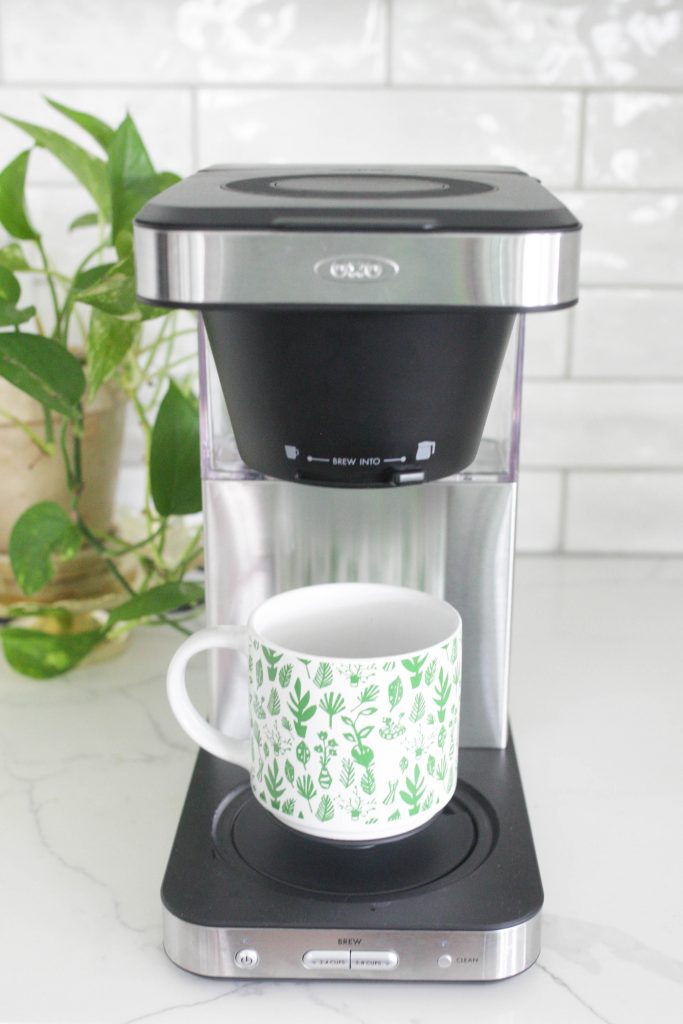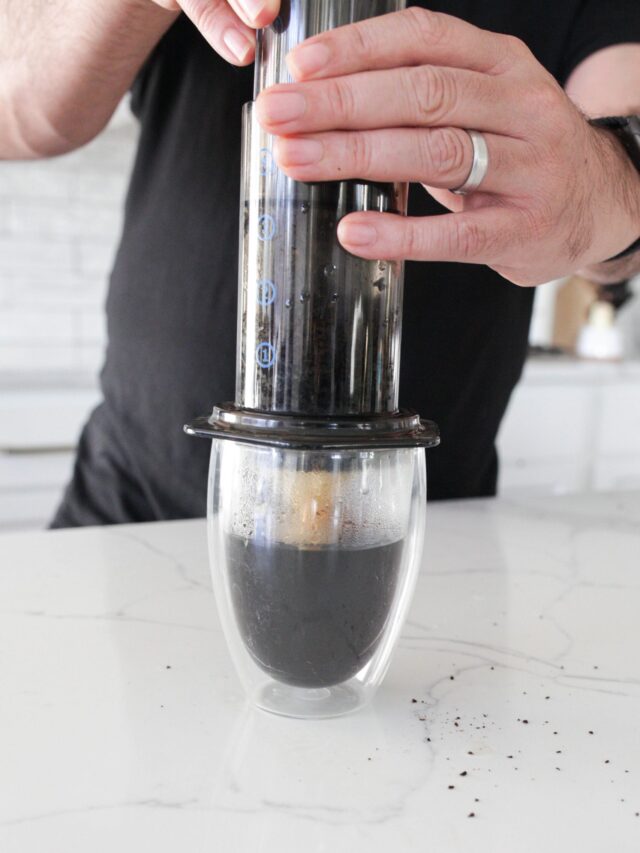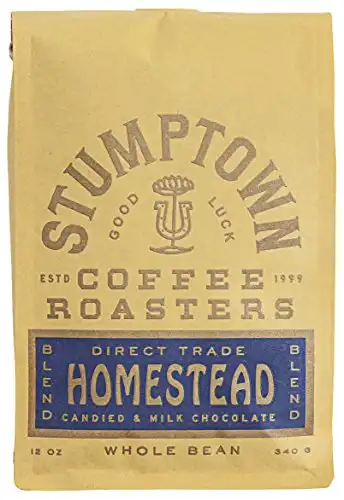The labels “medium roast” and “dark roast” refer to how hot a coffee bean got during its roasting process. And it’s actually quite amazing how much of a difference a few degrees of roasting temperature can make on the final cup of coffee.
Suppose you were to take two identical beans that were grown side-by-side on the same coffee plant, roast them to different degrees, and then taste test. The differences would be clear as day.
It isn’t just a difference in the color of the beans or how you brew them. Medium and dark roasts have different flavor notes, mouthfeels, and brewing styles that they’re suited for.
For the longest time, I knew there was a difference between coffee roasts, but it wasn’t something I could taste. That is until I completed a coffee unit at culinary school. It opened up my world through side-by-side taste tests of different roasts, origins, and brewing methods.
In this article, I’ll cover the differences between medium roast and dark roast coffee, and I’ll also share a few ideas for how you can replicate the taste tests that opened my eyes, without breaking the bank!

What is Dark Roast Coffee?
Dark roast coffee beans are dark brown in color. No surprise there. In most cases, you’ll also notice a sheen on the dark roast beans. The sheen is oil that adds to the brewed coffee’s rich, robust, full-bodied mouthfeel and flavor.
For a coffee to be considered a dark roast, the beans are roasted to a temperature between 430-440°F.
Dark roasts can get very dark. At the far end of the spectrum, you’ll find a French Roast and Italian Roast. On many roasting devices, the difference is subtle. It only takes about 30 seconds for the beans to transition from dark to French roast.

In this time, the appearance and flavor drastically change. Dark roasts have a more palatable smoky flavor indicative of the roast itself, whereas French roasts have a scorched malty flavor.
Dark roast coffees are exceptional for espresso drinks or any craft coffee that uses milk. These darker roasts can hold up against the high heat and pressure of espresso or Moka pot brewing.
Note: There’s a common misconception that espresso roast beans are a different type of bean, but these beans aren’t different from coffee beans, and traditionally most commercial espressos use dark roasts. If you go to a third-wave shop today, that is starting to change. The Medium-dark roasts type are becoming more en vogue.
If you like a full body and smoky coffee with notes of chocolate and toasted nuts, you’ll savor a mug of dark roast. Because the flavor profile is based on the roasted flavor, dark roasts will taste similar from origin to origin.
You might not notice a difference from roaster to roaster or brand to brand. As a result, you won’t notice the subtle flavor nuances of origin commonly associated with lighter roasts.
Peet’s Coffee sells a tasty and affordable Dark Roast with a flavor that’s quintessential to the profile.
However, if you want to splurge, try one of my favorite dark roasts, Copper Moon’s Dark Roast Sumatra Blend.
It’s herbal, earthy, and not too bitter.
What is Medium Roast Coffee?
Medium roast beans must reach between 400-430°F, which is a stark contrast to light roast beans that typically reach 380-400°F. This is what produces the balanced, slightly sweet, and not overbearing flavor that the roast is known for.
The beans have a medium brown coloring. They’re darker than blonde-looking light roast but much lighter than the muddy, almost black dark roasted bean. There may be the slightest oily sheen on a few of the beans, but for the most part, they’ll have a brushed matte exterior.
Medium roasts are versatile and can be used with delicate brewing methods like cold brew steeping all the way to rich espresso brewing. Medium roasts are often brewed with a Pour-Over or French Press device to emphasize the balanced flavor and body.
It’s a popular roast because it can span many flavor profiles and is compatible with various brewing methods. Medium roasts have enough coffee flavor to hold up against strong sweeteners.
But they aren’t too bitter or earthy to be off putting to some coffee drinkers. However, it’s more acidic than dark roasts, so those with sensitive stomachs should consider this and perhaps opt for a roast with less acidity.
Stumptown Coffee Roasters produces an excellent Medium Roast called Homestead Blend.
It combines dark-roast chocolatey flavors and light-roast fruity flavors like cherry and orange.
Differences Between Dark and Medium Roast Coffee
Appearance
Since dark roast is roasted longer than medium roast, the beans take on a darker color. They’ll be a deep dark brown. Sometimes almost a black hue.
As a result of this long roast, more oils are drawn to the bean’s surface. So dark roasted coffee beans often look slick and glossy instead of a medium roast’s matte finish.
Brew Methods
Dark roast coffee is often brewed with an espresso machine, stovetop percolator (like a Moka Pot), or an AeroPress.

These methods produce a concentrated, robust, and full-bodied espresso-like brew. The rich brew compliments a dark roast’s caramelized, toasty flavor.
Medium roast coffees take really well to a drip-method brew, like what you’d achieve with a Pour-Over or an immersion brew with a French Press.

Both of these methods are more gentle than the high-heat espresso methods used for a dark roast. This way, the more subtle flavor notes in medium roast are highlighted instead of disguised.
Popular Uses
Dark roast is almost exclusively used for espresso-like coffees. It’s often brewed by a humble auto-drip machine and served with cream and sugar. However, many agree that the best way to enjoy this roast as a Cuban coffee.
Medium roasts are a very versatile coffee. They’re smooth enough to be enjoyed black but flavorful enough to handle some dairy or sweetener. A medium roast can be brewed with a Pour-over device for a more tea-like result or with an espresso machine for a richer coffee.

Medium roasts are a great contender for black iced coffee or cold brew. It’s because they have enough robust flavor to stand up against the additional water from melting ice. At the same time, it’s mild enough to be enjoyed without milk or sugar to appreciate the bean’s nuanced flavor notes.
Bitterness
It’s the dark roasted flavor that most people describe as bitter. So, the darker the roast, the more dark, burnt, and bitter the coffee will taste.
Medium roast is significantly less bitter, so it’s more likely to be enjoyed black. Milk and sugar are added to dark roasts to mask the bitterness.
Acidity
The compounds that cause stomach cells to produce acid break down during the lengthy dark roasting process. This results in a less acidic coffee and makes dark roast the best option for drinkers with sensitive stomachs.
Light roasts will still have the most acidic compounds intact, and they’ll only decrease as the roast darkens.
Flavor
A dark roast will often have a robust, smoky, toasted flavor.
Dark beans are caramelized and carry an earthy, nutty, and chocolatey taste. There isn’t a considerable flavor difference from dark roast to dark roast because the flavor comes from the roast itself instead of the bean.
Medium roasts are more focused on highlighting the unique flavor of that specific bean. You’ll notice more fruity or floral notes and darker flavors typical of a dark roast. It’s the perfect middle between the subtle light roasts and possible overbearing dark ones.
A dark roast will have more bitter undertones, while a medium roast will lean more acidic.
Body
The body of coffee comes down to the amount of oil released into the brew. Since dark roasted beans have more oil than medium roasts, the resulting coffee will be fuller-bodied with a thicker mouthfeel.
Medium roasts will have a lighter, more well-rounded body that’s silky and velvety in the mouth.
Caffeine
The caffeine levels within coffee doesn’t drastically change from roast to roast. However, dark roast coffee has slightly less amount of caffeine than medium roast coffee beans. This is because the higher temperatures during the cooking process leads to the bean losing mass. Less mass means less bean to withhold caffeine overall.
Recap
To sum it up, dark roasts are great for those who prefer espresso-like brews and want a rich, bolder taste. They taste great with milk and sugar and will be easy on the stomach.
And there isn’t much flavor variation from bean to bean because the roast pilots this flavor more so than the origin.
Otherwise, choose a medium roast if you want a bean compatible with a brewing method like pour over or moka pot. Plus, it’ll be versatile enough to serve black or sweetened with a dash of dairy.
Once you taste the difference between these two roasts, you’ll see exactly what I mean. First, order a bag of each different types of roast. Then, brew them up and do a side-by-side taste test.
You could invite friends, print out some tasting note review cards, and have a coffee party. You’ll immediately know which roast profile you prefer, and that’ll lead you to more enjoyable coffee experiences.
FAQ
Dark roast will have a stronger roasted flavor than medium roast and only nominally less caffeine content.
Using mouthfeel and flavor, medium roasts will have a smooth, balanced taste and body. However, if you want a coffee that will be easy on your stomach, go for a dark roast because they’re less acidic.
Espresso can be made from all roast levels. Blonde espresso uses a light roast, and regular espresso can be made with either medium or dark roasts. Commercial operations and coffee chains most often use dark-roasted beans for their espresso.
Free Coffee Art Printables
Don’t forget to get on the list before you go! You’ll get 3 free coffee art printables delivered when you sign up and weekly coffee tips and tricks, product reviews!



